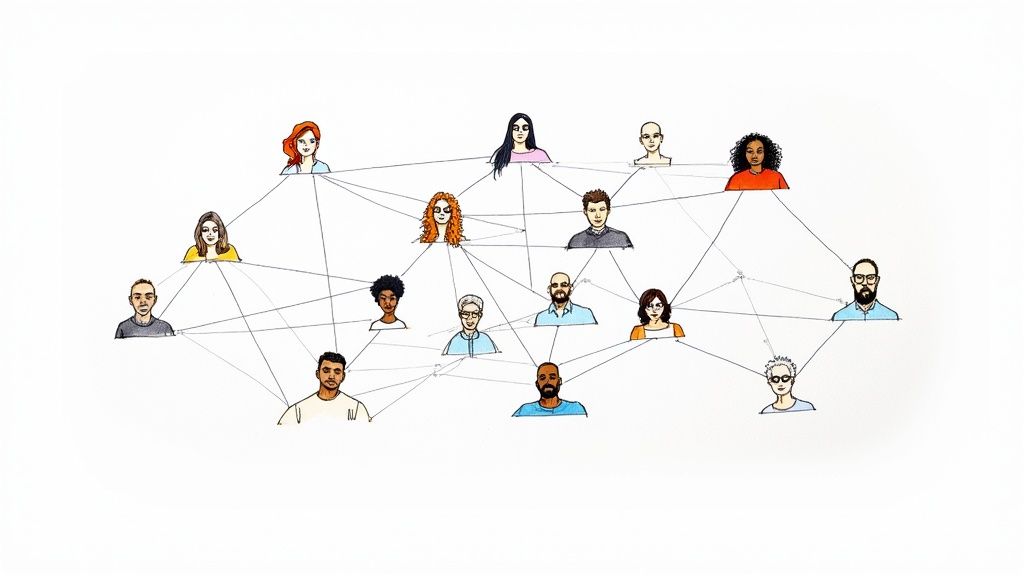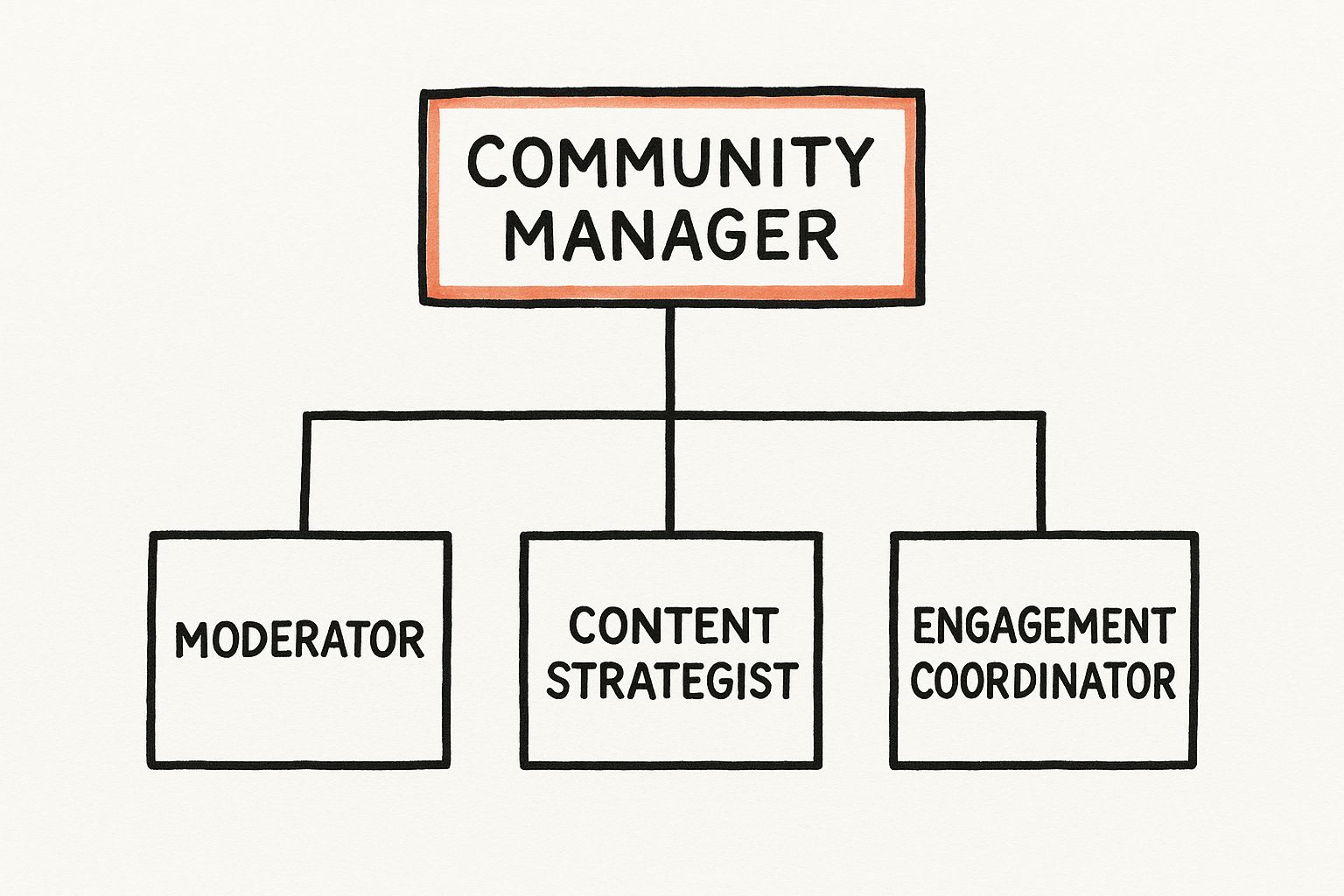July 31, 2025

Community management is one of those terms that gets thrown around a lot, but what does it actually mean? It's the craft of building, growing, and nurturing a group of people who are all connected by a shared interest, goal, or passion for a brand. This isn't about collecting followers; it's about turning a passive audience into a vibrant, active tribe of advocates who feel a real sense of belonging.
It goes way beyond just policing comments. Think of it as cultivating a thriving digital ecosystem.

Picture a classic town square. It’s where people naturally gather to swap stories, share ideas, and build real relationships. Now, imagine bringing that same energy and collaborative spirit into an online space for your brand. That's the heart of community management. It's the art and science of building an environment where every single member feels seen, heard, and genuinely valued.
A great way to think about the person in charge is as a digital gardener. Their job isn't just to plant the initial seeds by inviting people to join. They have to show up every day to tend to the garden, making sure it flourishes.
This involves:
One of the biggest misconceptions is that community management is just about deleting spam and nasty comments. While moderation is a crucial part of the job, it’s only one piece of a much bigger, more strategic puzzle. Real community management is a proactive discipline that ties directly back to core business objectives.
A well-managed community doesn't just talk at its members; it builds a two-way street for communication. It’s where a brand can listen, learn, and adapt based on direct feedback from its most dedicated users.
This strategic approach transforms a simple audience into a powerful, self-sustaining asset. By focusing on genuine human connection, brands can build a moat of loyalty that competitors simply can't cross. The entire focus shifts from transactional interactions (like a one-time sale) to relational ones, forging lasting bonds that fuel sustainable growth.
Let's take a closer look at how these responsibilities translate into tangible business value. The core functions of a community manager directly support key areas like customer retention, product development, and brand advocacy.
Here is a quick breakdown of the core functions and their impact:
As you can see, this role is deeply integrated into the health of the business.
The importance of this work isn't up for debate anymore; it's a proven driver of business success. Recent data reveals that 86% of businesses now consider community management to be essential to their mission. More telling, brands that foster active online communities achieve a 53% higher customer retention rate.
This isn't a fluke. It shows a widespread understanding that a strong community is a direct investment in a brand's health and future. That's why 72% of companies plan to increase their investment in community next year. You can dig into more of these key industry stats over at CreatorLabz.com.
Ultimately, understanding community management means seeing it for what it is: a vital bridge between a company and its people. It's how you stop chasing customers and start building a movement.
A great community doesn’t just happen. It's carefully built, piece by piece, on a strategic foundation. When we think about what is community management at a high level, it's really about mastering four key areas that all work in harmony to create a space people genuinely want to be a part of.
Think of it like building a house. You need a solid foundation, sturdy walls, a protective roof, and a welcoming door. In community building, these are your four essential pillars:
Getting this framework right takes you beyond simply reacting to daily tasks and gives you a repeatable blueprint for building something that lasts. Let's dig into what it takes to bring each pillar to life.
First up is engagement, which is really just the active, beating heart of your community. It’s the art of sparking real conversations and, most importantly, fostering those crucial member-to-member relationships. When people feel connected to each other, not just to your brand, you’ve found the magic.
Your job is to create opportunities for that magic to happen. Think daily discussion prompts, weekly "ask me anything" (AMA) sessions with experts, or even simple icebreaker threads for new folks. The goal is to make participation feel easy, rewarding, and natural.
While engagement brings the energy, moderation provides the psychological safety needed for that energy to stay positive. A community is only as strong as the trust people have in it. This makes clear guidelines and fair, consistent enforcement completely non-negotiable.
Effective moderation is so much more than just deleting spam. It’s about creating a clear code of conduct, having a transparent way to handle disagreements, and stepping in to de-escalate conflict before it poisons the well. A well-moderated space is one where people feel safe enough to be themselves, ask "dumb" questions, and share openly.
If engagement is the heart, content is the fuel that keeps the community engine running. It’s the "why" behind someone's decision to show up day after day. This pillar is all about creating and sharing valuable resources, discussions, and events that members can't get anywhere else.
A strong content plan should have a healthy mix of things to serve different needs. For instance:
This infographic shows how different roles can work together to execute a unified strategy across these functions.

As you can see, a successful community is often a team effort. You might have specialists handling content or safety, all guided by the community manager's overarching vision.
Finally, a healthy community is one that grows. This pillar isn't just about getting new members in the door; it's about turning your most passionate members into your biggest champions. These "super-users" are your single greatest asset for sustainable, organic growth.
The first step is to identify them. Who’s always answering questions, welcoming newcomers, and sharing positive feedback? Once you know who they are, nurture those relationships. Give them a special title, some behind-the-scenes access, or an "ambassador" role. When you empower them to share their stories and invite their friends, their word carries more weight than any marketing campaign ever could. For more on this, check out our guide on the top community building strategies for more actionable ideas.
By focusing on these four pillars, you're not just managing a forum—you're building a resilient, balanced ecosystem that retains members and becomes a powerful asset for your entire brand.

Community management isn't a one-size-fits-all job. The principles are universal, sure, but they apply to all sorts of groups, each with its own vibe and purpose. Getting a handle on these different models is the first step toward picking a structure that actually helps you hit your business goals.
Think of it like this: a gardener uses different tools and techniques for a rose garden than for a vegetable patch. In the same way, a community manager has to tailor their approach to fit the community's reason for being. Some are built to create die-hard brand fans, while others are all about members helping each other solve problems or grow professionally.
Choosing the right type from the get-go is a make-or-break decision. If you're just starting out, our guide on how to build an online community is a great resource for digging into that initial phase. Understanding these distinctions helps you create a space where people genuinely want to be.
Brand communities are all about creating a powerful, emotional bond between a company and its customers. You can think of them as a digital fan club. The real aim isn't just to push products; it’s to build a shared identity around the brand's mission and lifestyle.
Sephora's Beauty Insider community is a perfect example. People aren't just there to discuss Sephora's latest lipstick. They're sharing makeup tutorials, posting their favorite looks, and getting advice from other beauty junkies. This kind of authentic, user-generated content is gold because it builds trust and social proof in a way no advertisement ever could. The community becomes a destination in its own right, fostering loyalty that goes way beyond the checkout counter.
Product communities are closely related to brand communities, but they have a much sharper, more technical focus. Their main job is to help users get the absolute most out of a specific product or service. These spaces often become hubs for troubleshooting, sharing tips and tricks, and giving the company direct, unfiltered feedback.
Imagine a software company with a bustling product community. It’s a place where users can:
It’s a true win-win. Customers get help faster—often from a peer who just solved the exact same issue—and the company gets a direct pipeline of invaluable user feedback that can steer its entire product roadmap.
A product community transforms your user base from passive consumers into active collaborators. They become co-creators in your product’s evolution, which builds immense loyalty and a sense of ownership.
Communities of Practice (CoPs) are a different beast altogether. They bring together professionals who share a specific role, craft, or area of expertise. The entire point is to push their collective knowledge forward through shared learning and peer-to-peer support. It’s less about a single brand and more about the profession itself.
A private group for digital marketing managers is a classic CoP. In a space like that, members would discuss emerging industry trends, break down successful campaign strategies, and get advice on tough career challenges. The value is drawn from the collective wisdom of the members, creating an incredible resource for professional growth that benefits everyone involved.
The core ideas of community management don't just live online; they extend into the physical world through a field called Community Association Management (CAM). This area is booming, with fierce competition expected as an estimated 4,000 new community associations are projected to form in 2025 alone.
To keep up, 92% of management companies are planning to expand their portfolios. These numbers show that the fundamental skills of keeping people engaged and happy are just as critical for a neighborhood as they are for a digital forum. It proves that whether your community is online or on the same block, the goal is always to create a well-run, rewarding environment for every single member.
What makes a truly great community manager? It’s a special mix of skills. They have to be a strategist, a creator, a diplomat, and even a data analyst, all rolled into one. While no two days are the same, there’s a core set of abilities that separates the good from the genuinely exceptional.
It’s not just about being friendly online. The best community managers possess a balanced toolkit of both people-centric "soft skills" and technical "hard skills." This is what allows them to build real human connections while also proving the community’s impact on the business. For anyone building a career in this field, mastering these skills is the roadmap to success. For leaders, it’s the checklist for hiring the right person for this critical role.
At the end of the day, communities are about people. That's why soft skills are the absolute bedrock of community management. These are the interpersonal talents that build trust, help navigate tricky social situations, and create a culture where people feel like they belong. Without them, the most brilliant strategy is doomed to fail.
Here are the three soft skills that are completely non-negotiable:
Empathy: This is the big one. It's the ability to genuinely understand and share what another person is feeling. An empathetic manager can put themselves in a member's shoes, whether they're frustrated by a bug, thrilled about a new feature, or just feeling ignored. It’s the difference between a canned response and a real solution that makes someone feel heard.
Active Listening: This isn’t just about waiting for your turn to talk. Active listening means paying deep attention to what people are saying, understanding the emotion behind the words, and showing you get it. It also means noticing what isn't being said—like a subtle, recurring confusion around a product feature—and stepping in to help before it snowballs into a major issue.
Conflict De-escalation: Put a bunch of passionate people together, and disagreements are bound to happen. It's inevitable. A skilled manager knows how to step into a heated discussion not as a judge, but as a neutral guide. They can calmly enforce the rules, validate different points of view without picking sides, and steer the conversation back toward a productive outcome.
These skills aren't just "nice to have"—they are the tools you use to build psychological safety. When members feel safe, they share more openly, engage more authentically, and contribute in ways that make the entire community stronger.
If soft skills create the community's culture, hard skills build its structure and prove its worth. These are the more technical, teachable abilities that allow a manager to run campaigns, measure performance, and show a clear return on investment (ROI). They are a key part of defining what community management is from a business standpoint.
Essential hard skills include:
The most effective community managers are masters of both. They use their empathy to write a member survey that gets honest answers, their project management skills to get it launched smoothly, and their data analysis skills to turn the results into a compelling story for leadership. This ability to wear two hats is what makes them such a powerful asset to any company.

So, how do you prove your community isn't just a "nice-to-have" line item on a budget? The answer is all in the data. Measuring success is non-negotiable if you want to show the real business value of your work and secure continued investment.
To get this right, you have to look past the easy, surface-level numbers. Sure, a huge member count might look impressive at first glance, but it tells you nothing about whether people are actually engaged or if the community is making a difference. A truly effective measurement strategy is all about connecting what happens inside the community to tangible business outcomes.
A great way to approach this is to think about your metrics in three distinct levels. Each tier builds on the one before it, taking you from simple activity tracking to proving concrete business results. This framework helps you tell a complete and compelling story about your community's value.
Think of these as your community's vital signs. Health metrics are the fundamental indicators that tell you if your community is active and, well, alive. They're typically the easiest to track and give you a quick, at-a-glance read on daily operations.
These numbers show you've got a pulse. But to understand the quality of that pulse, you have to dig deeper.
This is where things get interesting. Engagement metrics measure the depth and quality of the interactions happening in your space. This is how you find out if you're building real relationships and a positive, self-sustaining culture. In fact, tracking these KPIs is a cornerstone of many successful community engagement strategies.
This final tier is the holy grail. It’s where you connect all that great community activity directly to the company's bottom line. These are the metrics that make executives sit up and take notice, proving the ROI of your work.
A thriving community isn't just a cost center; it's a value-creation engine. The right metrics make that value visible, transforming the perception of community management from a soft skill to a hard-hitting business driver.
The trick is to draw a straight line from a community behavior to a specific business goal. Here’s what that looks like in practice:
By tracking these three tiers together, you build a powerful business case. You start by showing the community is active (Health), then prove the activity is meaningful (Engagement), and finally, you demonstrate how it drives core business objectives (Business Impact). This data-backed approach is what separates good community management from great.
Let’s be honest: you can’t scale a thriving community on good vibes alone. While a great community manager is irreplaceable, the right technology is what truly powers a personal, engaging experience as you grow. It’s the engine running behind the scenes.
Think of your tech stack not as a random collection of software, but as a thoughtfully assembled toolkit. The goal isn't to have the most tools; it’s to have the right ones working in harmony. This is what allows you to automate the grunt work and turn raw data into smart decisions, all while keeping that human connection front and center. It’s the difference between feeling constantly swamped and being strategically in command.
Every community needs a central hub—a place where members gather, interact, and belong. This is your digital town square. A few years ago, that might have been a clunky online forum or a simple Facebook Group. Today, the game has changed completely, with dedicated platforms offering a far more powerful and integrated experience.
All-in-one community platforms like GroupOS or Circle are built from the ground up for this very purpose. They bring everything you need under one roof, creating a seamless, branded home for your members.
These platforms usually handle the essentials, like:
The beauty of an all-in-one platform is that it eliminates the disjointed feeling of sending members to Slack for chats, a different website for events, and yet another for content. It keeps everything in one place, which makes it easier for members to participate and for you to see what’s actually happening.
Once you have your home base, specialized tools can help you understand your members on a deeper level and streamline your day-to-day work. Analytics tools are your crystal ball for community health. They help you look past vanity metrics to see what’s really driving engagement. Which conversations are buzzing? Who are your most active contributors? What kind of content truly resonates?
Automation software, on the other hand, is your secret weapon for getting more done. These tools take on the repetitive, time-consuming tasks, freeing you up to focus on the stuff that actually requires a human touch—building relationships and fostering connection.
The goal of technology in community management is not to replace human connection but to remove the barriers that prevent it from scaling. Automation handles the logistics so you can focus on the relationships.
One of the biggest shifts we’re seeing, all powered by technology, is the move toward hyper-personalization. This isn't just about using someone's first name in an email. It’s about tailoring the entire experience—from content to communications—to an individual member's interests and behavior. It’s the antidote to generic, one-size-fits-all announcements.
Modern platforms make this possible by using member data intelligently. It's no surprise that consumer research shows a staggering 80% of people are more likely to do business with a company that offers personalized experiences. In a community, this translates directly to more trust and better retention. By segmenting members based on their activity, interests, or even how long they’ve been around, you can deliver custom onboarding paths, relevant content recommendations, and event invites that feel like they were made just for them. You can dive deeper into this and other key industry shifts by exploring these community strategies for 2025.
Navigating the world of community tools can feel overwhelming. To simplify things, we can group them into a few main categories based on what they do best.
Ultimately, the right choice depends entirely on your community's specific needs and goals. An all-in-one platform often provides the best foundation, but you might supplement it with specialized tools for chat or events as you scale.
When you're diving into the world of community management, a few questions tend to pop up again and again. Getting good answers to these is key to starting off on the right foot and understanding just how powerful this work can be. Let's walk through some of the most common ones I hear.
This is easily the biggest point of confusion for people new to the space. Both roles are online and involve talking to people, but that's where the similarities end. Their core jobs are fundamentally different.
A social media manager is a broadcaster. Their world is one-to-many communication. They’re the voice of the brand on public platforms like Instagram, X, or LinkedIn, pushing out messages to build brand awareness, attract new eyeballs, and get people to click a link. Think of them as being on a stage with a microphone.
A community manager, on the other hand, is a facilitator. We live for the many-to-many connections. Our entire job is to build relationships between members, creating a genuine sense of belonging that turns a loose group of people into a real network. We work inside a dedicated space—like a private forum, a Slack channel, or a platform like GroupOS—to help conversations and trust grow organically.
Here's the simplest way I explain it: A social media manager talks to an audience. A community manager helps an audience talk to each other.
Staring at a blank slate can feel overwhelming, but launching a community is totally doable when you break it down. It’s all about laying a solid foundation before you throw the doors open.
Let's be real: conflict is going to happen. Anytime you get passionate people together, disagreements are inevitable. The way you handle them is what separates a healthy, safe community from a toxic one. The trick is to be a firm but fair facilitator, not a heavy-handed judge.
Your first line of defense is a clear, public set of community guidelines. When trouble starts, they're your playbook. Step in early. You might acknowledge the tension publicly (if it’s already public), but immediately steer the difficult conversation into a private space, like DMs with the people involved.
Your job is to de-escalate. Listen to everyone, restate the rules of the road without pointing fingers, and focus on the behavior, not the person. The goal is always to enforce the guidelines consistently, protect the psychological safety of the entire community, and work toward a resolution that feels fair.
Ready to build, manage, and scale your own thriving community? GroupOS provides the all-in-one platform you need to handle memberships, events, content, and communication in one branded space. Start your free trial and see how easy it is to grow with GroupOS.


